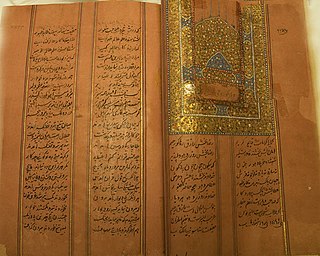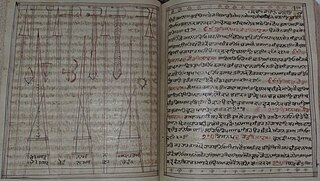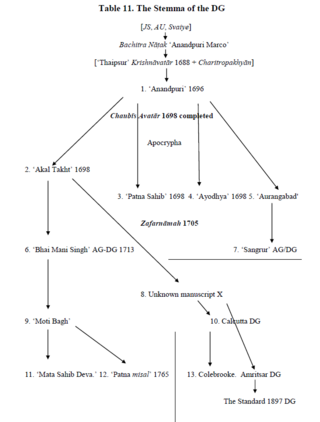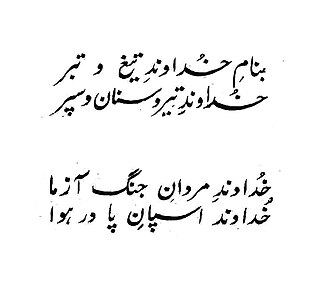
The Dasam Granth is a collection of various poetic compositions attributed to Guru Gobind Singh. The text enjoyed an equal status with the Adi Granth, or Guru Granth Sahib, in the eighteenth and nineteenth centuries and were installed side by side on the same platform. The Dasam Granth lost favor during the colonial period when reformist Singh Sabha Movement scholars couldn't contextualize the reworkings of Puranic stories or the vast collection of 'Tales of Deceit' Sri Charitropakhyan.

The Zafarnāma was a spiritual victory letter sent by Guru Gobind Singh in 1705 to the Mughal Emperor of India, Aurangzeb, after the Battle of Chamkaur.

The Sarbloh Granth or Sarabloh Granth, also called Manglacharan Puran or Sri Manglacharan Ji, is a voluminous scripture, composed of more than 6,500 poetic stanzas. It is traditionally attributed as being the work of Guru Gobind Singh, the tenth Sikh guru. Scholars, on the other hand, attribute the work to after the Guru's death, being authored by an unknown poet. The work is mostly revered by the Nihang sect.
Dharam Singh, born as Dharam Das, was one of the original Panj Pyare or the Five Beloved, the forerunners of the Khalsa.

The Bachittar Natak or Bachitar Natak is partly an autobiography of Guru Gobind Singh. The appellation Bachitar Natak is sometimes confusingly only applied around the Dasam Granth. The Bachitar Natak Granth, not to be confused with the Bachittar Natak composition, contains a large corpus of the Dasam Granth canon.
Daya Singh was one of the Panj Pyare, the first five Sikhs to be initiated into the Khalsa order in 17th-century India. Among the inaugural panj piare quintet, he is traditionally the highest-regarded as he was the first to answer the call for a sacrifice from the guru. Daya Singh was an educated Sikh, with literature being attributed to his authorship.

The principal Sikh scripture is the Adi Granth, more commonly called the Guru Granth Sahib. The second most important scripture of the Sikhs is the Dasam Granth. Both of these consist of text which was written or authorised by the Sikh Gurus.

Chandi Di Var also known as Vaar Durga Ki is a composition written by Guru Gobind Singh, included in the 5th chapter of Dasam Granth.

Akal Ustat is the name given to the second Bani present in the second holy scriptures of the Sikhs called the Dasam Granth. It is composed of 271 verses, and is largely devotional in nature.

The Battle of Chamkaur, also known as Battle of Chamkaur Sahib or the Second battle of Chamkaur, was fought between the Khalsa, led by Guru Gobind Singh, and the coalition forces of the Mughals led by Wazir Khan and Hindu hill chiefs. Guru Gobind Singh makes a reference to this battle in his letter Zafarnama.

Shabad Hazare, also known as Sabad Patshahi 10, under the title Shabad, are ten religious hymns composed by Guru Gobind Singh that are present in Dasam Granth. These hymns have comments on ritualistic practices in Sanyas, Jogis and Bairagis, and also against any form of idolatry, human or deity worship.

The history of the Dasam Granth is related to the time of creation and compilation of various writings by Guru Gobind Singh in form of small booklets, some of which are Sikh prayers. The first combined-codex manuscripts of the Dasam Granth were created during the Guru period. It is also said that after 1708, the Dasam Granth was allegedly compiled by Mani Singh Khalsa, contributed by other Khalsa armymen under direct instructions of Mata Sundari and this volume is recognized as Sri Dasam Granth Sahib. The present day Dasam Granth includes Jaap Sahib, Akal Ustat, Bachitar Natak, Chandi Charitar Ukati Bilas, Chandi Charitar II, Chandi di Var, Gyan Prabodh, Chaubis Avtar, Rudra Avtar, 33 Sawaiye, Khalsa Mahima, Shashtar Nam Mala Purana, Ath Pakh-yaan Charitar Likh-yatay and Zafarnamah.

Sri Charitropakhyan or Pakhyan Charitar and also Tria Charitra is a huge composition of short stories, with the purpose of learning from others' mistakes to acquire more refined judgement in all fields, present in Dasam Granth, which is generally and traditionally ascribed to Guru Gobind Singh. The composition contains 405/404 tales or episodes of wiles of men and women, containing many historical, mythological and philosophical aspects, having 7558 verses. This composition ends at Chopai which is one of the Nitnem banis. The term Charitropakhyan is derived from two words, Charitar means characteristics/function of character and Pakhyan means already told. There are two types of Charitars, Purakh Charitar and Tria Chariter.

Chaubis Avtar is a composition in Dasam Granth containing history of 24 incarnations (avatars) of Vishnu.

33 Savaiye is a religious work written by Guru Gobind Singh which is included in Dasam Granth, second scripture of Sikhs. It is present after Sabad Patshahi 10 and continued with Khalsa Mahima. It explains qualities of Supreme and the Khalsa.

Fatehnama, also known as Namah-i-Guru Gobind Singh or the Jangnamah is a Persian composition attributed to Guru Gobind Singh. It was contained within the Dasam Granth.

Bhai Gurdas Singh, also known as Bhai Gurdas II, was a Sikh during the time of Guru Gobind Singh. He is most known for writing a Vaar. He was one of the traditionally-ascribed 52 poets of the Kavi Darbar of Guru Gobind Singh, being one of the three most renowned and famous of the group.

Santhiya or Santhya is the correct pronunciation (ucharan) of Gurbani, taught in the manner of the 10th Sikh Guru, Guru Gobind Singh. It is comparable to the Islamic tajwid. Santhiya is almost always taught via a giani, who then teaches a vidyarthi (student). Educated vidyarthis can also teach other Sikhs santhiya. It involves the precise recitation and flow (rhythm) of the Gurbani that is being recited. Color codes to stop and pause, known as vishraams, are commonly used to dictate the flow and rhythm of the recitation. Gurbani which is recited by a person who has taken santhiya is known as "shudh ucharan"

Anandpur Lipi is a calligraphic style of the Gurmukhi script associated with Guru Gobind Singh. It is commonly found among early manuscripts of the Dasam Granth scripture as the employed script.

The Gurbilas literature, or Gurbilases, refers to a genre of Sikh chronicle literature that records the biographies and historical narrations of the sixth and tenth Sikh gurus, namely Guru Hargobind and Guru Gobind Singh. They are similar to the Janamsakhi literature that contains biographies on the life of Guru Nanak. All of the main Gurbilas texts are traditionally attributed to the 18th century but their dates of completion are contested by scholars, who date them variously.





















